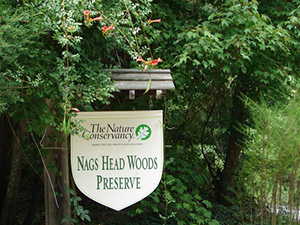Today, Nags Head Woods is one of the most diverse and interesting of the maritime forests that line the sound side of the Outer Banks. It is administered by the Nature Conservancy and is one of four patches of maritime forest that have been preserved in our area.
The other three maritime forests — Currituck Banks Reserve, Kitty Hawk Woods, and Buxton Woods — are wonderful places to enjoy nature and are definitely worth a visit, but none of them are quite as varied in terrain or offer the vistas and landscapes of Nags Head Woods.
And none of them come even close to its remarkable history.

The 1100 acre Nags Head Woods is the actually the north end of a tract that once extended to Jockey’s Ridge State Park. Among the dunes, hardwood trees, fresh ponds, and swamps, a small community took root.
There was no census taken for just Nags Head Woods, no count of the community, so we may never know exactly how many people lived there, but the evidence is everywhere.
There is little doubt that Native Americans were living in the heavily forested hills of what we now consider Nags Head Woods. They left little evidence that they were there, though, and it wasn’t until the mid 18th century that the first European settlers arrived.
The first residents likely arrived and started farming the land claiming squatter’s rights. Over time those original settlers acquired deeds to the land, and some of the oldest family names in Dare County lived there—the Tilletts, the Tolers, Manns, and Baums.
If family legend is accurate, most of the land was originally owned by a Tillett after being given all of Nags Head Woods from sound to sea by a land grant from the Lord’s Proprietors. Certainly, the Tilletts were one of the original families in Nags Head Woods with gravesite dating their arrival in the 1700s.
Scattered ruins, a brick wall that may once have been part of a home or a barn…all of it giving evidence of a once small but thriving community. Family cemeteries are scattered throughout the reserve; some easily seen rest beside Old Nags Head Woods Road. Others, like the Baum site, are off a rarely used trail that leads to Run Hill.
It is the Baum cemetery that gives evidence of a more complex and nuanced history than may be thought at first glance.

In a 1985 recording of Nags Head local Calvert Duvall, he mentions that some of the landowners in Nags Head Woods owned slaves. After the Civil War, some of the former slaves stayed on the properties. In the segregated world of the time, even in passing regardless an African American would not be buried with a white family.
That would seem to be the case with David Baum, 1845-1923. Interred at the Baum cemetery, his grave is distinctly separate from the other family members.
There were perhaps 200 people that lived in Nags Head Woods—maybe a few more, maybe a few less. There were two churches, a small store, a grist mill, and a one-room schoolhouse teaching grades 1-7 taught by Noah Hurdle, described by Duvall as a strict and a no-nonsense teacher.
Although the community was noted for taking care of its own, there was a rivalry between the south end of Nags Head Woods and the north end, according to Lu Anne Jones in her book “Everyone Helped His Neighbor: Memories of Nags Head Woods.” On the south end, many of the residents primarily fished and were called somewhat derogatorily “down south soft crabbers,” and on the north end where there were more farms, there were the “hog feed peddlers.”
Numerous accounts created an image of a remarkably self-sufficient community. Most of the residents farmed the land, growing staple crops such as potatoes, sweet potatoes, and garden vegetables. Jone’s book and the Duval tapes describe farms that raised cattle, hogs, and sheep.
To supplement their farm income and food, almost everyone hunted and fished. There was an ice house—the ice cut from the sound in the winter—to preserve fish and game until the packet boat from Elizabeth City came to take the goods to market.
It is also apparent that in some cases, especially on the south end, residents would work in the tourist town of Nags Head.
Food items that could not be grown, hunted or fished were purchased in bulk, either from a trip to Manteo or from the local store, which made a trip to Elizabeth City once a month to stock up. Typically this would include products like salt, sugar, and flour.
Flour was especially important. Duval noted, “…biscuits were at the table three times a day.”
It was perhaps inevitable that the Nags Head Woods community would make way for modern times. By the 1930s, roads connected the Outer Banks with the outside world. The final death knell was probably WWII and its aftermath when good paying jobs beckoned in Hampton Roads and other cities.
Threatened with development in the 1970s, Nags Head Woods was designated as a National Natural Landmark in 1974. In 1992, Nags Head Reserve was created.
Lu Anne Jones book “Everyone Helped His Neighbor: Memories of Nags Head Woods” has just been reissued.
